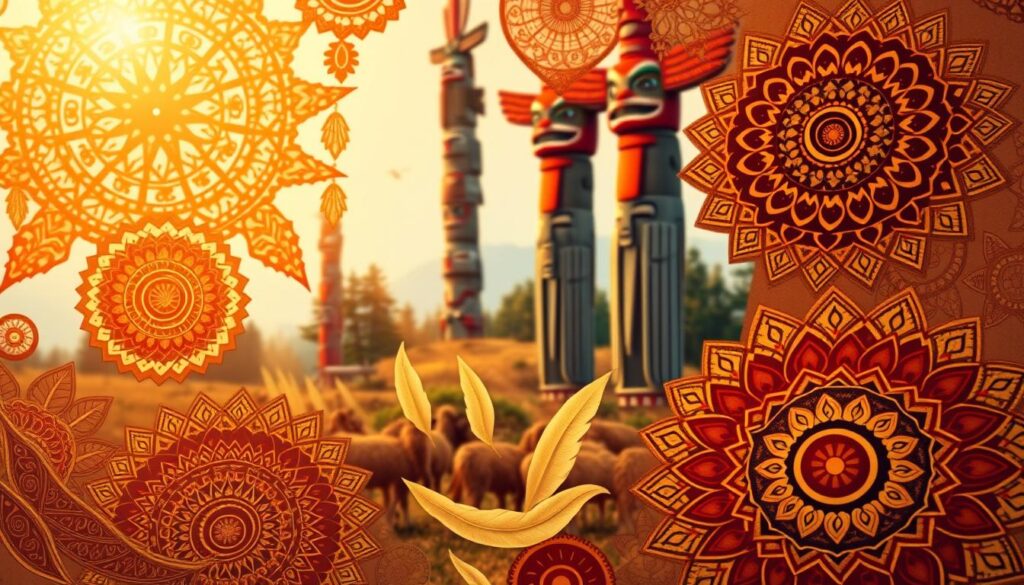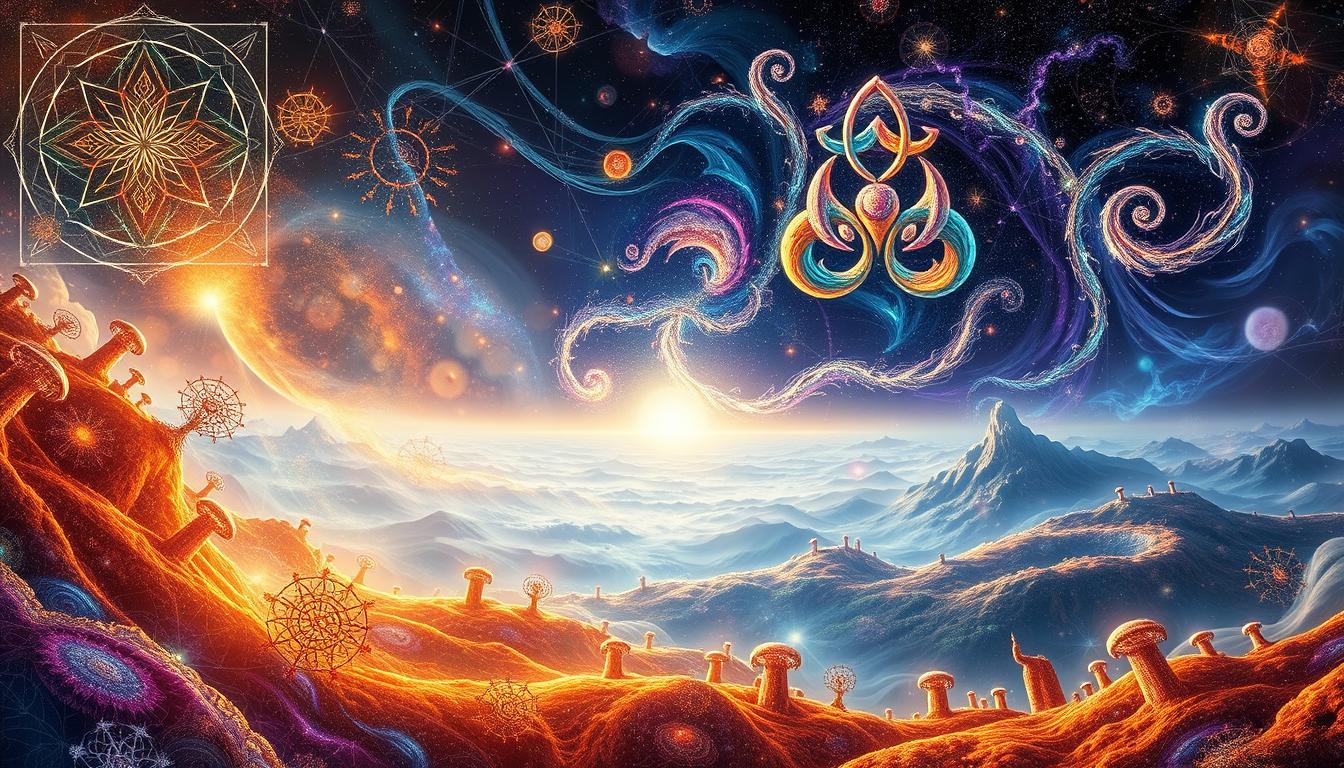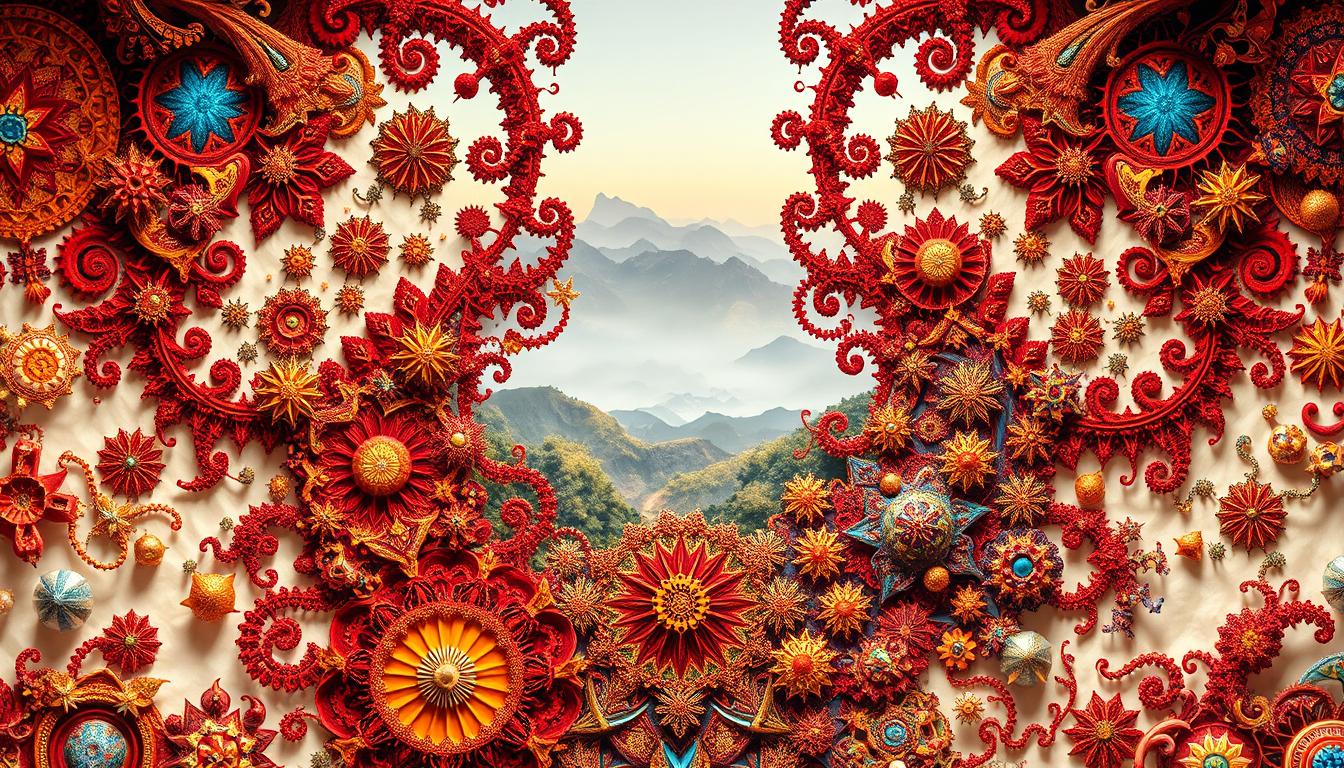The beautiful world of sacred symbols and fractal geometry shows a deep link in indigenous beliefs. These elements play a key role in the cultural and spiritual lives of these communities. By exploring how they are used across different cultures, we can learn about their art and buildings.
This journey helps us discover the rich knowledge within indigenous traditions. It highlights the beauty and significance of sacred symbols and fractal designs.
Understanding Sacred Symbols in Indigenous Cultures
Sacred symbols are crucial for expressing cultural identity in indigenous cultures. They carry deep spiritual meanings. These symbols reflect the community’s beliefs and values. They include images that show cosmic principles and the relationship between life and the spiritual world.
These symbols are more than just art. They are part of rituals and ceremonies that deepen the spiritual life of people. Through these symbols, indigenous peoples show how they connect with nature, their ancestors, and the universe. This strengthens the sense of belonging and keeps their culture alive.
When we learn about sacred symbols, we gain a greater respect for indigenous cultures. The stories within these symbols keep history and traditions alive. They help pass down important beliefs and practices to future generations.

Introduction to Fractal Geometry
Fractal geometry is a cool area of math that looks into strange, often wild patterns in the universe. It studies complex shapes that are the same in different sizes, which helps us understand the world better. Through fractals, we can see how nature combines simplicity and complexity.
Definition and Characteristics of Fractal Geometry
Fractal geometry focuses on patterns that repeat on many levels. These patterns have a quality called self-similarity, where small parts of a shape look like the whole thing. This cool feature lets fractals show irregular but repeated structures in nature. Fractal features are:
- Non-integer dimensions, showing their complexity.
- Scaling invariance, meaning we can see these shapes in the same way no matter the size.
- Recursion, where patterns repeat within themselves, adding more complexity.
The Role of Fractals in Nature
Fractals are everywhere in nature, appearing in things like coastlines, clouds, and the branches of trees. These self-similar patterns add beauty and detail to the world, showing the math beneath. By looking at fractals, we learn how complex things come from simple rules. Nature shows us fractals through:
- Plants like ferns and broccoli, with repeating growth patterns.
- Natural wonders, such as snowflakes and mountains, with fractal shapes.
- Weather systems and ocean currents, with complicated, self-similar routes.
Importance of Sacred Symbols in Spiritual Practices
Sacred symbols are vital in spiritual traditions of native cultures. They symbolize divine safety and are pathways for healing and spiritual links. By using these symbols in rituals, people grow closer to their cultural beliefs.
Rituals and Ceremonies Involving Sacred Symbols
In rituals, sacred symbols play a key role. They might appear as designs on objects or textiles. These symbols guide and support during spiritual events. Adding them to rituals lets people connect with ancestral forces and culture.
Cultural Significance of Symbolic Artwork
For indigenous communities, symbolic art is more than beauty. It carries cultural stories and beliefs. Each artwork narrates a special tale, linking humans with nature and the divine. This art reinforces cultural identity and honors long-standing spiritual practices. It deepens respect for native spiritual ways.
Intersecting Beliefs: Mathematics and Spirituality
The concept of sacred geometry brings together math and spirituality. It shows how numbers and spiritual meaning can merge. This lets people see the universe’s beauty and order. Indigenous beliefs highlight this mix, showing nature as a place full of math.
Many native cultures see nature with sacred geometry in mind. They find patterns that follow life’s rhythm. These shapes are meaningful symbols. They teach about harmony, balance, and how everything is connected.
This view creates a meaningful way to look at the world. It connects fractals and shapes with traditions. Ceremonies include these elements, showing math’s role in spirituality. It suggests numbers and patterns reveal a bigger truth. This leads to a deeper spiritual journey.
Sacred Symbols and Fractal Geometry in Indigenous Beliefs
Indigenous cultures mix sacred symbols with fractal geometry. This blend enhances their art and spiritual practices. Fractal patterns in their art don’t just look pretty. They also share deep cultural stories and beliefs.
Fractal Patterns in Indigenous Art
Indigenous art shows complex fractal patterns. These mirror the natural and spiritual worlds. The designs symbolize life, death, and the cycle of existence. Artists use shapes to capture the world’s essence and their beliefs. This creates a visual language full of meaning.
How Sacred Symbols Resonate with Fractal Concepts
Sacred symbols reflect fractal geometry principles. This shows how everything in life is connected. It deepens how cultures express themselves. Symbols can mean different things on many levels. The mix of these ideas shows a deep understanding of both material and spiritual worlds. It makes the cultural heritage of indigenous communities richer.
Examples of Fractal Geometry in Indigenous Architecture
Indigenous architecture around the world uses special designs that include fractal geometry. These patterns show how culture, spirituality, and the environment are linked. We will look at these patterns in African architecture and Hindu temples.
Patterns in African Architecture
African architecture shows fractal geometry in its traditional designs. These structures often display the social order and cultural values of their communities. You can see these patterns in:
- Urban Planning: Many African cities have layouts that show fractal patterns, with neighborhoods having similar shapes.
- Building Structures: Homes and public buildings often have repetitive geometric patterns, blending well with nature.
- Cultural History: Architectural styles tell the stories of different ethnic groups, mixing creativity with practicality.
Fractals in Hindu Temple Design
The design of Hindu temples is a great example of fractal geometry in spiritual buildings. These places have detailed designs that reflect spiritual beliefs. Highlights include:
- Recursive Motifs: Fractal patterns are found on temple exteriors, showing the vastness of the universe.
- Complex Layouts: Temples are carefully designed, with each part having spiritual meaning and symmetrical fractal designs.
- Symbolic Architecture: The geometry in Hindu temples expresses deep ideas, highlighting the bond between the sacred and the natural world.
The Influence of Colonialism on Indigenous Sacred Symbols
Colonialism has deeply affected indigenous cultures, changing how sacred symbols are seen. Foreign powers taking over caused these symbols to be misused, transforming cultures deeply. This misuse often made the symbols lose their sacred meanings, breaking the core of indigenous beliefs.
Transformations in Symbolism
Indigenous groups have struggled to keep their sacred symbols meaningful because of colonialism. These changes happened in different ways:
- Adaptation of sacred symbols to match new religious ideas from colonizers.
- Loss of original meanings, making cultural identity weaker.
- Mixing colonial images into sacred designs, confusing the original beliefs.
These changes have had a big impact, creating a mix of traditional and new identities. This mix tests the strength and truth of indigenous cultures.
Anthropological Perspectives on Sacred Geometry
Anthropological studies show a deep link between sacred geometry and indigenous cultures. By looking into these links, experts learn more about society and identity. Sacred geometry shapes various cultural expressions, like art, rituals, and buildings.
These studies point out important facts:
- Sacred geometry is a global language, helping different cultures talk to each other.
- It’s key in indigenous knowledge, representing spiritual beliefs and lessons.
- It shows community values and brings people together.
Studying sacred geometry through anthropology helps us understand how indigenous peoples express their views and life. It offers insights into their identities and the importance of their customs.
Exploring the Intersection of Art and Fractal Geometry
Art blends complex fractal geometry ideas with deep spiritual themes. This mix not only shows nature’s pattern beauty but also carries deep cultural meanings. Artists use these complex ideas, sharing messages that touch our hearts and minds.
Art as a Medium for Conveying Spiritual Concepts
Artists use fractal geometry in art to show spiritual stories. This way, they can share beliefs and values unique to certain cultures. Some ways they do this include:
- Utilization of repeating patterns that reflect natural structures.
- Exploration of color and form to evoke emotional responses.
- Integration of symbolism that connects viewers to cultural heritage.
The chat between art and math opens doors to deeper spiritual understanding. By using fractals, artists make pieces that are not only lovely to look at but also make us think about our place in the universe.
The Future of Fractals in Understanding Indigenous Beliefs
Fractals open new doors to understand indigenous beliefs better. Scholars and artists see how math and spirituality meet. Fractals show the depth of cultural stories, keeping their importance alive.
Using fractals helps us see patterns in sacred symbols. This lets researchers dig into the layers of spiritual meaning. It shows how important it is to understand different cultures, drawing more interest in these traditions.
Looking ahead, teams of mathematicians, artists, and indigenous peoples are key. They’ll blend modern methods and timeless wisdom. This mix keeps cultural heritage alive and leads to new interpretations of our world.
Conclusion
The study of sacred symbols and fractal geometry in indigenous beliefs shows a deep understanding of cultures and spirituality. We’ve looked at how these ideas are linked. Sacred symbols show core beliefs, and fractal geometry reflects nature’s patterns. This shows how math helps us get these cultures and highlights the beauty of human life.
Understanding sacred symbols and fractal geometry is important for grasping indigenous beliefs. They are more than just old items; they represent the cultures that made them. Valuing these connections helps us respect their spiritual and artistic ways.
In the end, sacred symbols and fractal geometry make us think about the deep meanings in indigenous beliefs. Let’s continue to learn from these traditions. And let’s honor the vast knowledge they bring to our world today.



